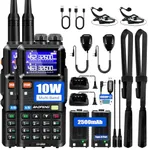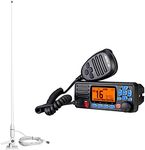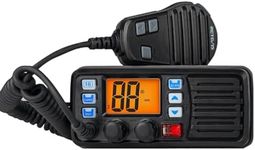Buying Guide for the Best Handheld Ham Radios
Choosing the right handheld ham radio can be a bit overwhelming, especially if you're new to the hobby. Handheld ham radios, also known as handheld transceivers or HTs, are portable devices that allow you to communicate over various frequencies. They are popular among amateur radio enthusiasts for their portability and versatility. When selecting a handheld ham radio, it's important to consider several key specifications to ensure you get a device that meets your needs and preferences.Frequency RangeThe frequency range of a handheld ham radio determines the bands on which it can operate. This is important because different bands are used for different types of communication. Common frequency ranges include VHF (Very High Frequency) and UHF (Ultra High Frequency). VHF is typically used for longer distances and outdoor communication, while UHF is better for urban environments with obstacles. If you plan to use your radio in various settings, a dual-band radio that covers both VHF and UHF might be the best choice.
Power OutputPower output, measured in watts, affects the range and clarity of your transmissions. Higher power output can extend your communication range but may also drain the battery faster. Handheld ham radios typically offer power outputs ranging from 1 to 8 watts. For general use, a radio with 5 watts of power is usually sufficient. If you need to communicate over longer distances or in challenging environments, consider a model with higher power output.
Battery LifeBattery life is crucial for handheld ham radios, especially if you plan to use the radio for extended periods or in emergency situations. Battery life can vary significantly depending on the power output and usage. Look for radios with long-lasting batteries or the option to use replaceable batteries. Some models also offer power-saving features to extend battery life. If you need a radio for long outings or emergencies, prioritize models with robust battery performance.
DurabilityDurability is an important factor, especially if you plan to use your handheld ham radio in rugged environments. Look for radios that are built to withstand drops, dust, and water exposure. Many models come with an IP rating that indicates their resistance to dust and water. For outdoor adventures or harsh conditions, choose a radio with a high IP rating to ensure it can handle the elements.
Display and InterfaceThe display and interface of a handheld ham radio can greatly affect ease of use. A clear, easy-to-read display is important for quickly accessing information and settings. Some radios offer backlit displays for better visibility in low light conditions. The interface should be intuitive, with well-placed buttons and controls. If you're new to ham radios, look for a model with a user-friendly interface to make operation simpler.
Additional FeaturesMany handheld ham radios come with additional features that can enhance your experience. These may include GPS, weather alerts, programmable memory channels, and more. Consider which features are important to you based on your intended use. For example, GPS can be useful for outdoor activities, while weather alerts are beneficial for staying informed during emergencies. Choose a radio with features that align with your specific needs and interests.
























